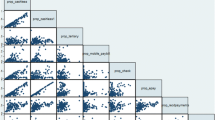Abstract
Empirical evidence from the 1980s and 1990s indicates that cash use in the U.S. remains high even though there has been a proliferation of alternatives to cash. This paper examines the dynamics of inflation and asset prices in response to innovations in the efficiency of processing noncash transactions. The quantitative results suggest that inflation is more sensitive than nominal interest rates or real equity prices to innovations in the efficiency of non-cash payments processing. Thus, as alternatives to cash payment become more prominent, the volatility of real interest rates may increase.(JELE31, E41, G12)
Similar content being viewed by others
References
Campbell, John Y., and John H. Cochrane. 1999. “By Force of Habit: A Consumption-Based Explanation of U.S. Stock Market Behavior.”Journal of Political Economy 107: 205–251.
Cecchetti, Stephen, P. S. Lam, and Nelson Mark 1993. “The Equity Premium and the Risk Free Rate: Matching the Moments.”Journal of Monetary Economics 31: 55–93.
Christiano, Lawrence J. 1994. “Modelling the Liquidity Effect of a Money Shock.” InInventory, Business Cycles, and Monetary Transmission, edited by Riccardo Fiorito: 61–124. New York, NY: Springer-Verlag.
Cochrane, John H. 1999. “Money as Stock: Price Level Determination with no Money Demand.” University of Chicago working paper.
Constantinides, George M. 1990. “Habit Formation: A Solution of the Equity Premium Puzzle.”Journal of Political Economy 98: 519–543.
Hancock, Diana, David B. Humphrey, and James A. Wilcox. 1999. “Cost Reductions in Electronic Payments: The Roles of Consolidation, Economics of Scale, and Technical Change.”Journal of Banking and Finance 23: 391–421.
Hancock, Diana, and David B. Humphrey. 1998. “Payments Transactions, Instruments, and Systems: A Survey.”Journal of Banking and Finance 21: 1573–1624.
Hodrick, Robert J, Narayana Kocherlakota, and Deborah Lucas. 1991. “The Variability of Velocity in Cash in Advance Models.”Journal of Political Economy 99: 358–384.
Ireland, Peter N. 1995. “Endogenous Financial Intermediation and the Demand for Money.”Joural of Money, Credit, and Banking 27: 107–123.
Jefferson, Philip N. 2000. “Home Base and Monetary Base Rules: Elementary Evidence from the 1980s and 1990s.”Journal of Economics and Business 52: 161–180.
— 1998. “Seigniorage Payments for Use of the Dollar: 1977–1995.”Economics Letters 58: 225–230.
King, Robert G., and Charles I. Plosser. 1984. “Money, Credit, and Prices in a Real Business Cycle.”American Economic Review 74: 363–380.
Kocherlakota, Narayana. 1996. “The Equity Premium: It’s Still a Puzzle.”Journal of Economic Literature 34: 42–71.
Lacker, Jeffrey M., and Stacey L. Schreft. 1996. “Money and Credit as Means of Payment.”Journal of Monetary Economics 38: 3–23.
Lucas, Robert E., Jr., and Nancy L. Stokey. 1983. “Optimal Fiscal and Monetary Policy in an Economy without Capital.”Journal of Monetary Economics 12: 5–93.
Mehra, Rajnish, and Edward Prescott. 1985. “The Equity Premium: A Puzzle.”Journal of Monetary Economics 15: 145–161.
Porter, Richard D., and Gretchen C. Weinbach. 1999. “Currency Ratios and U.S. Underground Economic Activity.”Economics Letters 63: 355–361.
Porter, Richard D., and Ruth A. Judson. 1996. “The Location of U.S. Currency: How Much is Abroad?”Federal Reserve Bulletin 82: 883–903.
Scheinkman, Jose A. 1980. “Discussion.” InModels of Monetary Economies, edited by J. Kareken and N. Wallace. Federal Reserve Bank of Minneapolis, Minneapolis.
Svensson, Lars E.O. 1985. “Money and Asset Prices in a Cash-in-Advance Economy.”Journal of Political Economy 93: 919–944.
Townsend, Robert M. 1987. “Asset-Return Anomalies in a Monetary Economy.”Journal of Economic Theory 41: 219–247.
Walsh, Carl E. 1998,Monetary Theory and Policy. Cambridge, MA: MIT Press.
Author information
Authors and Affiliations
Additional information
This research is supported by a Swarthmore College Faculty Research Grant and a Eugene M. Lang Faculty Fellowship.
Rights and permissions
About this article
Cite this article
Jefferson, P.N. Price dynamics when there are alternatives to cash payment. J Econ Finan 25, 149–171 (2001). https://doi.org/10.1007/BF02744519
Issue Date:
DOI: https://doi.org/10.1007/BF02744519




